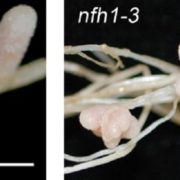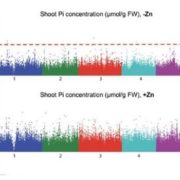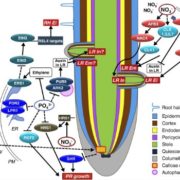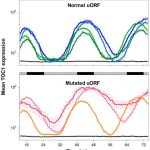Review: Molecular regulators of nitrate response in plants (Curr. Biol.)
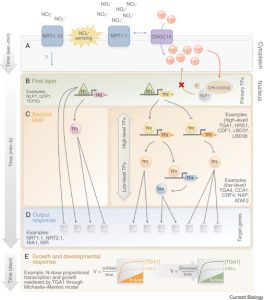 Nitrate is the major form of nitrogen used by plants in an aerobic crop cultivation scenario. Lamig et al. review recent additions to the already vast knowledge of nitrate signaling. A first line of regulation concerns nitrate uptake through post-transcriptional and post-translational regulation of nitrate transporters. Both low affinity (NRT1) and high affinity (NRT2) nitrate transporters are regulated by specific phosphorylation events determining their affinity or functionality. For example, Ser 501 phosphorylation suppresses NRT2.1 mediated nitrate transport under high nitrate supply. Many exciting new developments concern how information about nitrate availability regulates downstream events. Nitrate transporters are known as “transceptors” as they act as both transporters of nitrate and receptors that trigger downstream processes. (Furthermore, NRT1.1 can also transport auxin.) A recent study reports that under low nitrate conditions the cyclic nucleotide gated channel CNGC15 forms a heterocomplex with NRT1.1 and is inactivated, whereas under high nitrate conditions CNGC15 disassociates from NRT1.1 and functions as a calcium channel. Other processes are under the control of nitrate-responsive transcription factors. For example, the nitrate dependent nuclear retention of NLP7 regulates the expression of around 60% of nitrate induced genes. However, NLP7 is just one transcription factor within a large and complex regulatory hierarchy. The review also explores the mechanisms through which nitrate fine-tunes early plant development, including cotyledon and leaf growth and root and shoot architecture. Further studies are needed to address organ specific responses to nitrate, long term nitrate signaling, and interaction of nitrate signaling with other environmental factors. This expansive understanding of nitrate signaling and plant growth, mediated by the cooperation of multiple transcription factors, will aid in improving crop nitrogen use efficiency (Summary by Lekshmy Sathee @lekshmysnair) Curr. Biol. 10.1016/j.cub.2022.03.022
Nitrate is the major form of nitrogen used by plants in an aerobic crop cultivation scenario. Lamig et al. review recent additions to the already vast knowledge of nitrate signaling. A first line of regulation concerns nitrate uptake through post-transcriptional and post-translational regulation of nitrate transporters. Both low affinity (NRT1) and high affinity (NRT2) nitrate transporters are regulated by specific phosphorylation events determining their affinity or functionality. For example, Ser 501 phosphorylation suppresses NRT2.1 mediated nitrate transport under high nitrate supply. Many exciting new developments concern how information about nitrate availability regulates downstream events. Nitrate transporters are known as “transceptors” as they act as both transporters of nitrate and receptors that trigger downstream processes. (Furthermore, NRT1.1 can also transport auxin.) A recent study reports that under low nitrate conditions the cyclic nucleotide gated channel CNGC15 forms a heterocomplex with NRT1.1 and is inactivated, whereas under high nitrate conditions CNGC15 disassociates from NRT1.1 and functions as a calcium channel. Other processes are under the control of nitrate-responsive transcription factors. For example, the nitrate dependent nuclear retention of NLP7 regulates the expression of around 60% of nitrate induced genes. However, NLP7 is just one transcription factor within a large and complex regulatory hierarchy. The review also explores the mechanisms through which nitrate fine-tunes early plant development, including cotyledon and leaf growth and root and shoot architecture. Further studies are needed to address organ specific responses to nitrate, long term nitrate signaling, and interaction of nitrate signaling with other environmental factors. This expansive understanding of nitrate signaling and plant growth, mediated by the cooperation of multiple transcription factors, will aid in improving crop nitrogen use efficiency (Summary by Lekshmy Sathee @lekshmysnair) Curr. Biol. 10.1016/j.cub.2022.03.022


